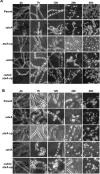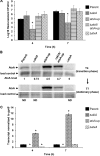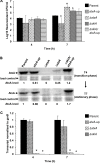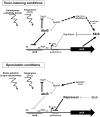A Dual Role for the Bacillus anthracis Master Virulence Regulator AtxA: Control of Sporulation and Anthrax Toxin Production
- PMID: 29599764
- PMCID: PMC5862856
- DOI: 10.3389/fmicb.2018.00482
A Dual Role for the Bacillus anthracis Master Virulence Regulator AtxA: Control of Sporulation and Anthrax Toxin Production
Abstract
Bacillus anthracis is an endemic soil bacterium that exhibits two different lifestyles. In the soil environment, B. anthracis undergoes a cycle of saprophytic growth, sporulation, and germination. In mammalian hosts, the pathogenic lifestyle of B. anthracis is spore germination followed by vegetative cell replication, but cells do not sporulate. During infection, and in specific culture conditions, transcription of the structural genes for the anthrax toxin proteins and the biosynthetic operon for capsule synthesis is positively controlled by the regulatory protein AtxA. A critical role for the atxA gene in B. anthracis virulence has been established. Here we report an inverse relationship between toxin production and sporulation that is linked to AtxA levels. During culture in conditions favoring sporulation, B. anthracis produces little to no AtxA. When B. anthracis is cultured in conditions favoring toxin gene expression, AtxA is expressed at relatively high levels and sporulation rate and efficiency are reduced. We found that a mutation within the atxA promoter region resulting in AtxA over-expression leads to a marked sporulation defect. The sporulation phenotype of the mutant is dependent upon pXO2-0075, an atxA-regulated open reading frame located on virulence plasmid pXO2. The predicted amino acid sequence of the pXO2-0075 protein has similarity to the sensor domain of sporulation sensor histidine kinases. It was shown previously that pXO2-0075 overexpression suppresses sporulation. We have designated pXO2-0075 "skiA" for "sporulation kinase inhibitor." Our results indicate that in addition to serving as a positive regulator of virulence gene expression, AtxA modulates B. anthracis development.
Keywords: Bacillus; anthrax; biological; development; sporulation; toxins; transcription factors.
Figures






References
-
- Ausubel F. M. (1993). Current Protocols in Molecular Biology. New York, NY: Greene Publishing Associates and Wiley-Interscience.
-
- Barnes J. M. (1947). The development of anthrax following the administration of spores by inhalation. Br. J. Exp. Pathol. 28 385–394.
Grants and funding
LinkOut - more resources
Full Text Sources
Other Literature Sources

